Physical Address
304 North Cardinal St.
Dorchester Center, MA 02124
The human neural tube is thought to close in an intermittent, multisite pattern, and neural tube defects that present as midline cutaneous lesions (e.g. cephaloceles, heterotopic brain tissue, rudimentary meningoceles) typically occur at the junction between two closure sites
Midline lesions of the nose and scalp have a high likelihood of representing developmental defects with a potential intracranial connection, and an evaluation with CT or MRI prior to surgical intervention is critical
The presence of a “hair collar” surrounding a lesion on the scalp is a sign of ectopic neural tissue or membranous aplasia cutis; the latter is thought to represent a forme fruste of a neural tube defect
Cutaneous lesions overlying the spinal axis can serve as a marker for spinal dysraphism, and their presence is often an indication for radiologic evaluation
Aplasia cutis congenita, a physical finding reflecting a disruption of intrauterine skin development, can be approached clinically based on the morphology and distribution of lesions as well as the presence or absence of associated abnormalities
A number of other developmental anomalies affect the skin; although they usually represent isolated defects, it is important to be aware of potential associated conditions
Developmental anomalies are a diverse group of congenital disorders that result from faulty morphogenesis. They include both malformations , defined as structural defects arising due to errors in embryologic development, and disruptions , which occur when a structure programmed to develop normally is damaged before it is fully formed. A classic example of the former is incomplete closure of the neural tube resulting in an encephalocele, while the latter process is illustrated by the anomalies associated with varicella embryopathy. Although developmental anomalies that affect the skin are often recognized at birth or during infancy, occasionally diagnosis is delayed until later in life. The cutaneous abnormalities range in severity from isolated, minor physical findings (e.g. rudimentary supernumerary digits) to deforming, potentially life-threatening defects (e.g. deep, irregular scalp aplasia cutis congenita in Adams–Oliver syndrome). Furthermore, some skin lesions that themselves appear to be innocuous may serve as important clues to the presence of a multiple congenital anomaly syndrome or, particularly when involving the midline, the existence of a serious defect of the underlying tissues. Such associations reflect the complex interactions between various ectodermal and mesodermal elements that occur during the intricate processes of morphogenesis and differentiation.
This chapter begins with an overview of the midline lesion and its relationship to closure of the neural tube. A discussion of specific issues pertaining to midline lesions of the nose, scalp and spine follows, including a review of the different types of anomalies that can present in these sites. An overview of aplasia cutis congenita is followed by presentation of a clinical approach based on the morphology and distribution of lesions and the presence or absence of associated abnormalities. Finally, a variety of non-midline developmental anomalies are discussed, including lip pits, accessory tragi, supernumerary nipples, skin dimples, malformations of the dermatoglyphs, rudimentary supernumerary digits, and the amniotic band sequence. Developmental anomalies that are covered in Chapter 110 include ear pits as well as branchial cleft, thyroglossal duct, bronchogenic, median raphe, omphalomesenteric duct, and urachal cysts.
A number of critical events occur during the third to fifth weeks of embryologic development (see Ch. 2 ). These include formation of the neural tube, separation of neuroectoderm from surface ectoderm, and interposition of mesodermal elements. Inherent in such a complicated process is the potential for error, which spans a spectrum from obvious, fulminant neural tube defects to subtle cutaneous anomalies. However, the latter may represent a sign of a significant underlying malformation.
Classically, closure of the human neural tube was thought to be a continuous process, beginning at a single focus in the cervical region and progressing bidirectionally in a “zipper-like” fashion to culminate in the closure of the anterior and subsequently posterior neuropores. However, evidence suggests that in humans as well as other mammals, the cranial segment of the neural tube closes in an intermittent or multisite pattern. Four distinct initiation sites of neural tube closure have been identified in the mouse, and a similar pattern of closure has been proposed for humans, with an additional caudal site ( Fig. 64.1 ) . In support of the multisite closure model, neural tube defects (e.g. cephaloceles, myelomeningoceles, heterotopic brain/meningeal tissue) cluster either entirely within one closure site or at the junction of two sites, such as the nasal root (2–3) or vertex (2–4; see Fig. 64.1 ). Neural tube closure in the posterior cranial area is thought to occur via a membrane rather than a midline fusion of folds, and the appearance of this site during embryologic development in animals resembles that of human membranous aplasia cutis . Specific genes may control individual closure sites, explaining repetitive events within families.
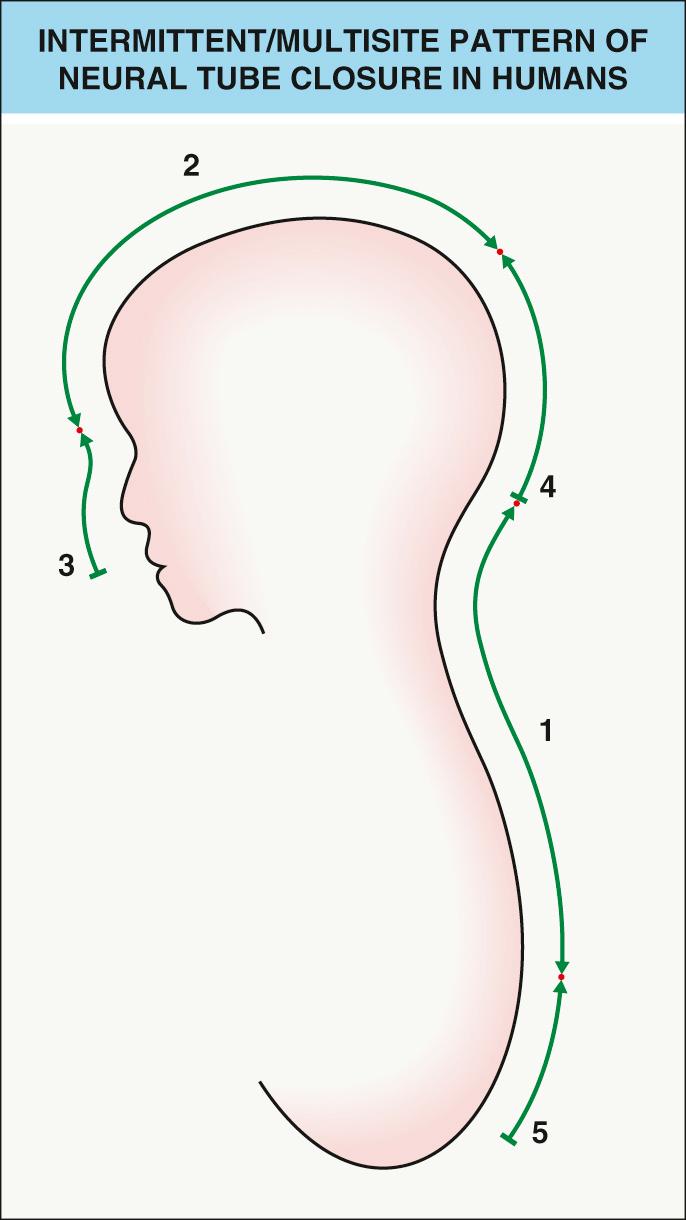
The pathogenesis, differential diagnosis and management of midline lesions of the nose ( Fig. 64.2 ) and scalp are discussed below, followed by a review of the individual developmental anomalies that may present with a midline lesion on the head or neck. Midline cysts of this region (e.g. thyroglossal duct, bronchogenic) are discussed in Chapter 110 .
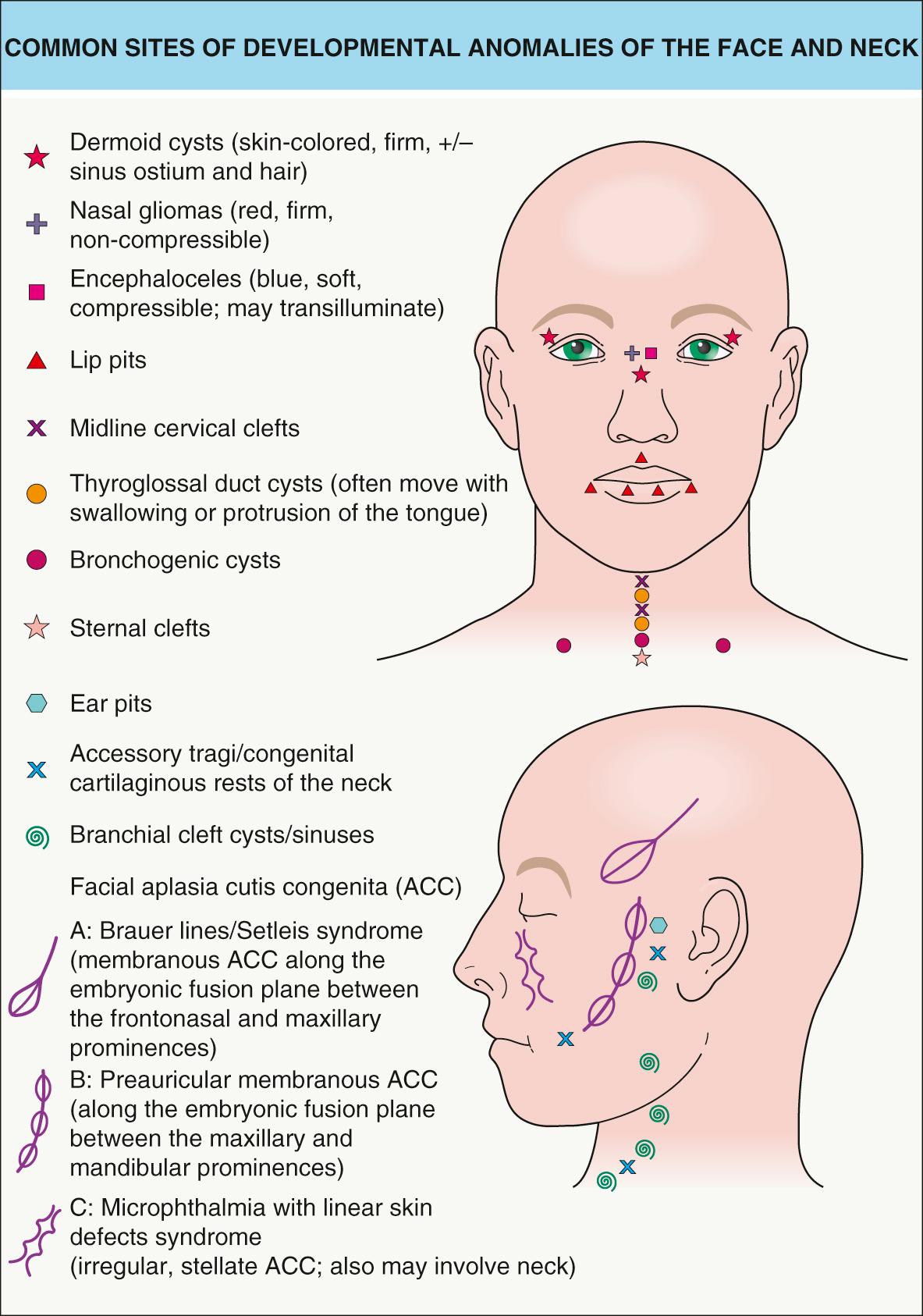
It is important for physicians to recognize the potential intracranial connection of a midline nasal mass or pit . Dermoid cysts, dermal sinuses, cephaloceles, and heterotopic brain tissue (nasal gliomas) resulting from faulty embryologic development of the frontobasal skull and/or adjacent ectodermal/neuroectodermal tissues all may present as congenital nasal lesions ( Table 64.1 ). As a group, these midline nasal masses occur in ~2–5 per 100 000 live births. They are often misdiagnosed as more familiar entities such as epidermoid cysts and infantile hemangiomas.
| THE DIFFERENTIAL DIAGNOSIS OF NASAL MASSES PRESENTING AT BIRTH OR DURING INFANCY |
| Developmental defects |
| Other cysts |
|
| Benign neoplasms and hamartomas |
|
| Malignant neoplasms |
|
The various congenital midline nasal masses have similar developmental origins. As the bones of the skull form during the second month of gestation, diverticula of dura mater project: (1) inferiorly into the prenasal space that extends from the base of the skull to the nasal tip, deep to the nasal bone and skin but superficial to the nasal cartilage; and (2) anteriorly through the nasofrontal fontanelle into the glabellar area. These diverticula may make connections with the overlying dermis, but usually they regress completely, with subsequent bony fusion to form the base of the skull and the cribriform plate. However, if the dura mater does not separate from the dermis, an ectodermal residue, with or without a patent intracranial connection, can persist; furthermore, if faulty neural tube closure results in a bony defect, there may be herniation of brain tissue. Such ectopic elements can occur either within the prenasal space (nasoethmoidal, “intranasal”) or superiorly at the glabella (nasofrontal, “extranasal”) . Depending on the contents of the lesion (e.g. cutaneous versus neural tissue, cyst versus tract only) and the patency of the intracranial connection, a dermoid cyst, dermal sinus, cephalocele, or nasal glioma results (see below).
Many of these midline nasal lesions have the potential for intracranial communication, and, consequently, present a risk for the development of serious CNS infections such as meningoencephalitis or a brain abscess. In addition, recurrent inflammation and progressive expansion of the mass may result in bony atrophy and nasal distortion. Early and complete surgical excision with repair of associated bony and dural defects is imperative. In order to prevent ascending infections, a biopsy, needle aspiration, or other preoperative manipulations should be avoided.
A thorough radiologic evaluation prior to surgery is mandatory. Ultrasound may detect some bony defects but has limited sensitivity. While CT is the most sensitive method for defining bony skull defects, false-positive studies are common in young children undergoing bone maturation. MRI is superior in demonstrating intracranial masses and other soft tissue changes and may aid in planning surgical approaches . In addition, surgical exploration is often necessary to definitively exclude the presence of an intracranial connection, as small fibrous tracts may not be detectable with imaging studies.
Subcutaneous nodules of the scalp are common, and in adults they are usually acquired lesions, such as epidermoid and tricholemmal cysts. However, midline scalp lesions that are noted at birth or in early childhood have a high likelihood of representing developmental defects, such as dermoid cysts, cephaloceles, heterotopic brain or meningeal tissue, and aplasia cutis congenita. In one series of 70 children presenting with a solitary, non-traumatic scalp nodule , 61% of the lesions were dermoid cysts and 4% cephaloceles. More importantly, 37% of the lesions were found to extend intracranially to the dura or brain.
In the evaluation of a patient with a subcutaneous nodule on the scalp, clinical clues that heighten suspicion of a developmental anomaly with potential intracranial extension include :
a patient who is an infant or child
a lesion first noted at birth or during early childhood
a family history of neural tube defects
a history of meningitis
the presence of neurologic signs or symptoms
location of the lesion along the midline or over the suture lines of the scalp
lesions that pulsate, transilluminate, or fluctuate in size with crying or straining
lesions with a central pore in young children, who are less likely to have epidermoid cysts
an overlying capillary malformation (port-wine stain)
a positive hair collar sign (see below).
A congenital midline lesion, or a scalp nodule with other concerning features, requires imaging studies prior to surgical excision or biopsy. If a bony defect is detected by ultrasound or CT, a follow-up MRI may be indicated to better evaluate whether there is extension of soft tissue transcranially. A neurosurgical referral is indicated if these studies are positive and, as small communications may be missed, complete surgical removal may be prudent even if they are negative .
The hair collar sign consists of a ring of long, dark, coarse hair surrounding a congenital scalp nodule. The presence of a hair collar is a relatively specific marker for ectopic neural tissue . Hair collars are also seen in membranous aplasia cutis ( Figs 64.3 & 64.4 ), a disorder thought to represent a forme fruste of a neural tube defect (i.e. without the presence of ectopic neural tissue) . Drolet et al. hypothesized that cerebral herniation produces aberrant shearing forces during the formation of hair follicles early in development, causing them to point outward from the defect. The proximity of neuroectoderm expressing neural adhesion molecules may also alter normal epidermal–dermal interactions, thereby inducing the development of large, abnormal follicles . These speculations correlate with the histologic and dermoscopic finding of numerous horizontally oriented, hypertrophic follicles emerging from the edge of scalp lesions to form the hair collar . The differential diagnosis and evaluation of a positive hair collar sign is presented in Fig. 64.5 .
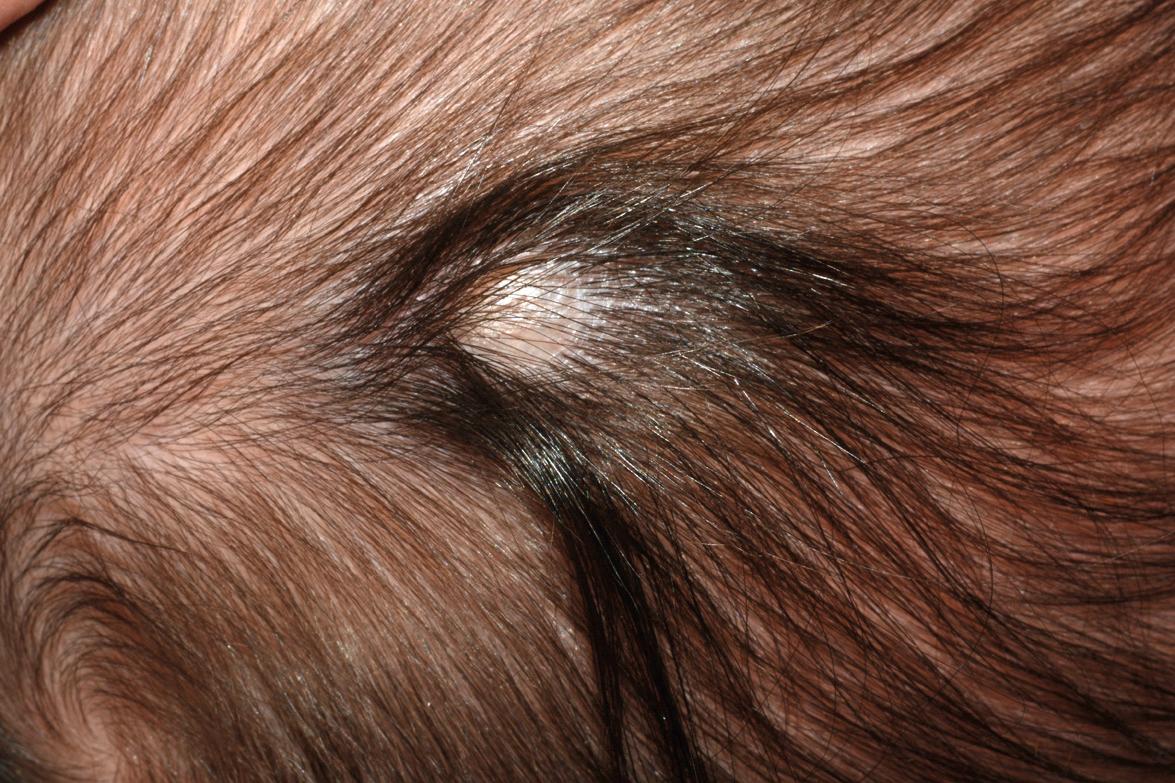
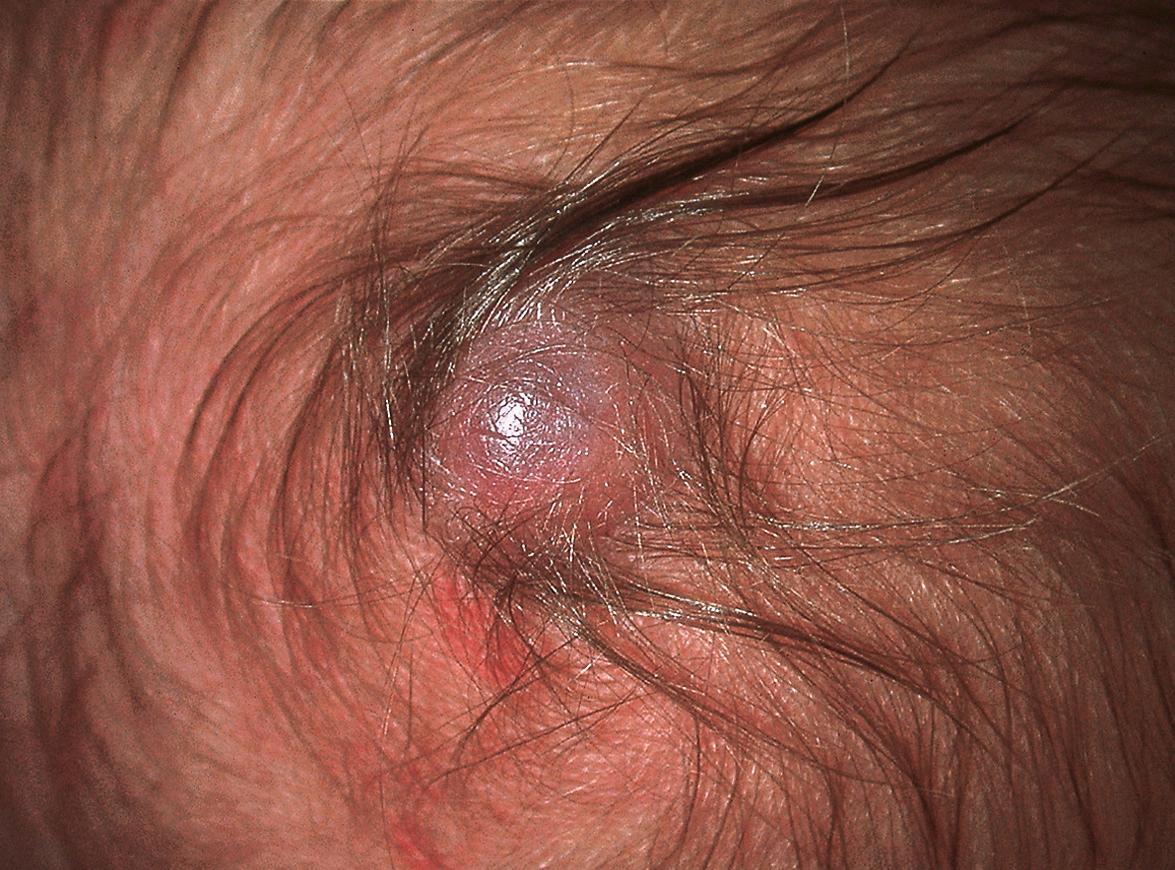
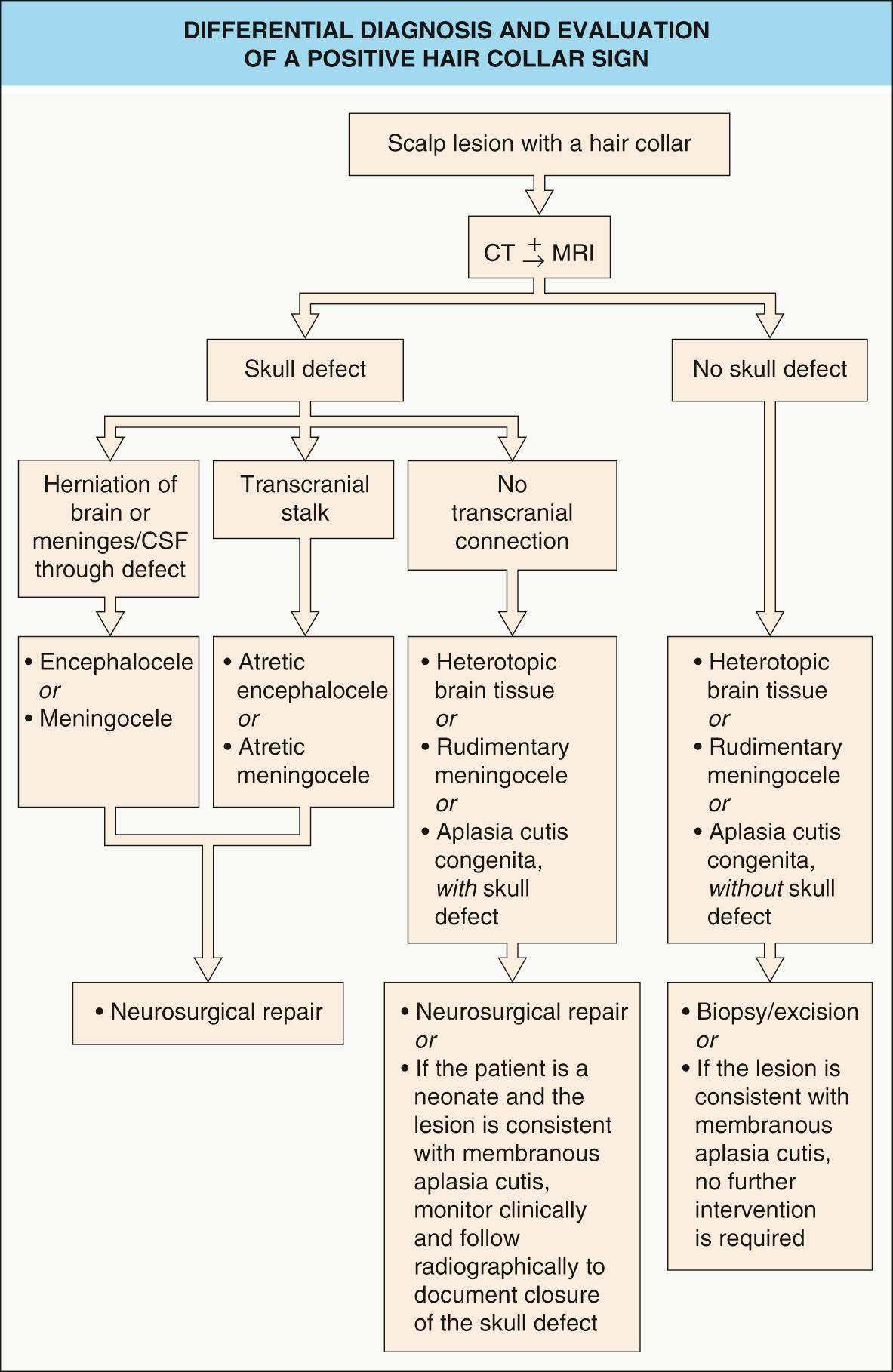
Sinus pericranii is a rare disorder characterized by a congenital, or occasionally acquired, epicranial venous malformation of the scalp that communicates with an intracranial dural sinus through dilated diploic cranial veins . The lesion is usually located near the midline, especially in the frontal region. Most are asymptomatic and appear as a compressible, fluctuant mass that varies in size with changes in intracranial pressure ( Fig. 64.6 ). The differential diagnosis includes a simple venous or arteriovenous malformation, meningocele or encephalocele.
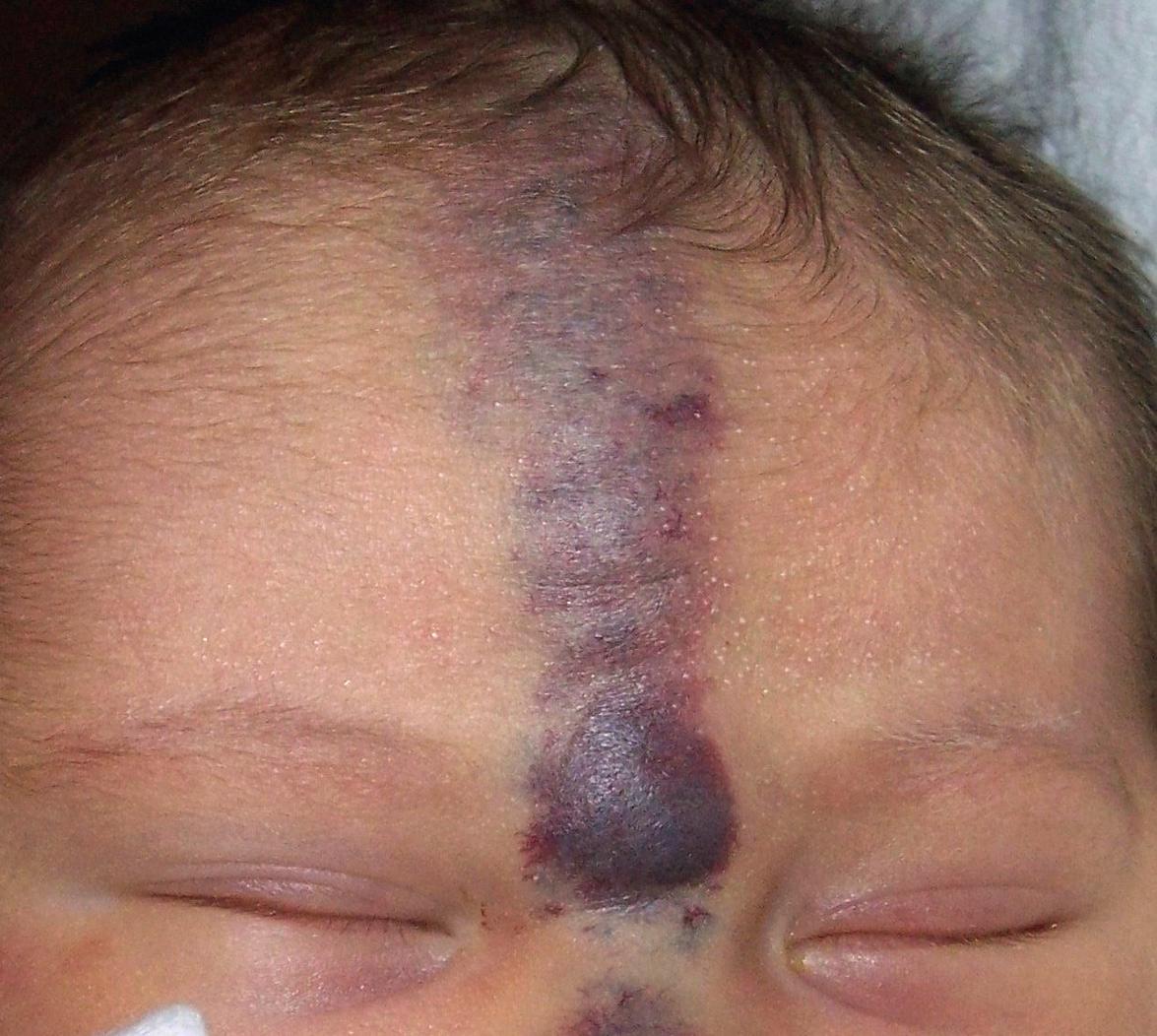
Hairless congenital scalp lesions such as a nevus sebaceus (see Chs 62 & 111 ) and nevus psiloliparus (a hallmark of encephalocraniocutaneous lipomatosis; see Ch. 62 ) due to mosaic activating mutations may mimic developmental anomalies of the scalp.
Dermoid cysts result from sequestration of ectodermal tissue along embryonic fusion planes during development. They are a separate entity from benign cystic teratomas, neoplasms that are also referred to as dermoids. Although dermoid cysts are congenital defects and may be recognized at birth, these lesions often escape notice until they become enlarged, inflamed, or infected. This typically occurs by early childhood, but diagnosis may be delayed until as late as the sixth decade of life. Dermoid cysts present as firm, non-compressible, non-pulsatile subcutaneous nodules that often reach a size of 1–4 cm in diameter. The lesions usually do not transilluminate. They are most commonly located around the eyes, particularly the lateral eyebrow ( Fig. 64.7 ), but may also be found on the nose, scalp (often over the anterior fontanelle or the midline occiput), neck, sternum, sacrum, and scrotum.
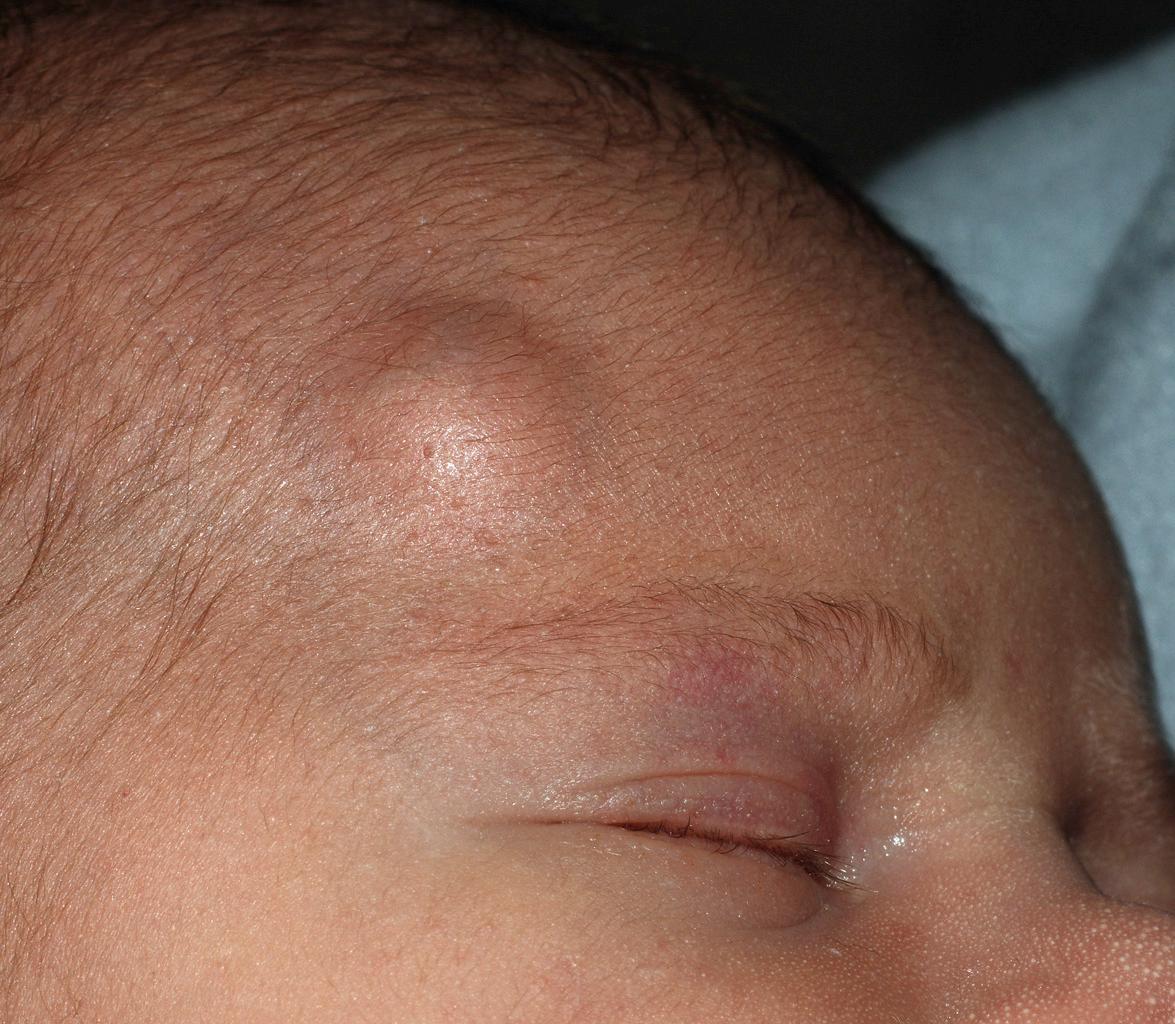
Dermoid cysts on the nose or midline scalp have a much higher likelihood of intracranial extension than those in a periocular location. Nasal lesions, which account for <10% of cervicofacial dermoid cysts, occur anywhere from the glabella to the tip of the nose (see above) and can result in a widened nasal bridge. The presence of a sinus ostium, which may be heralded by protruding hairs or a sebaceous discharge, increases the risk of intracranial involvement of a nasal dermoid cyst to almost 50%, versus ~25% overall . A sinus ostium without an underlying subcutaneous mass may also connect with an intracranial dermoid cyst. These lesions favor the midline occipital area but can occur elsewhere on the face and scalp; recurrent drainage and inflammation may represent signs of deeper extension . In addition to infectious complications, a chemical meningitis or even hydrocephalus due to release of keratinous and sebaceous material into the cerebrospinal fluid (CSF) can occur with intracranial dermoid cysts. Lastly, dermoid cysts and dermal sinuses overlying the spine may be associated with occult dysraphism (see below) and if the tract connects with the subarachnoid space, an increased risk of meningitis.
Histologically, dermoid cysts in any location are lined by keratinizing stratified squamous epithelium and contain mature adnexal structures (see Ch. 110 ) . Treatment is by excision, and preoperative imaging studies are required for lesions located on the nose, midline scalp, or posterior axis or those with other suspicious features (e.g. a draining sinus ostium) in order to exclude a connection to the CNS.
Cephalocele is a general term for congenital herniation of intracranial structures through a defect in the skull. Cranial meningoceles are herniations in which the sac contains meninges and CSF, while encephaloceles contain both meninges and brain ( Fig. 64.8 ). Therefore, by definition, all cephaloceles have an intracranial connection. These lesions result from faulty closure of the cephalic portion of the neural tube during development, and they are much less common than their caudal counterparts (e.g. myelomeningoceles). Cephaloceles occur in ~1–3 per 10 000 live births, with a higher incidence in those with a family history of neural tube defects and an ~5% risk of neural tube defects in subsequent siblings. They are usually midline or paramedian, occurring most frequently at the occiput or vertex (75%) (see Fig. 64.1 ), followed by extranasal (e.g. glabella or medial orbit; 15%) and intranasal or pharyngeal (10%) locations . Encephaloceles are generally noted early in life due to the resultant deformity. Occasionally, small frontal lesions are misdiagnosed as deep infantile hemangiomas, vascular malformations, hypertelorism, or nasal polyps ; of note, the latter are almost never seen in children younger than 3 years of age.
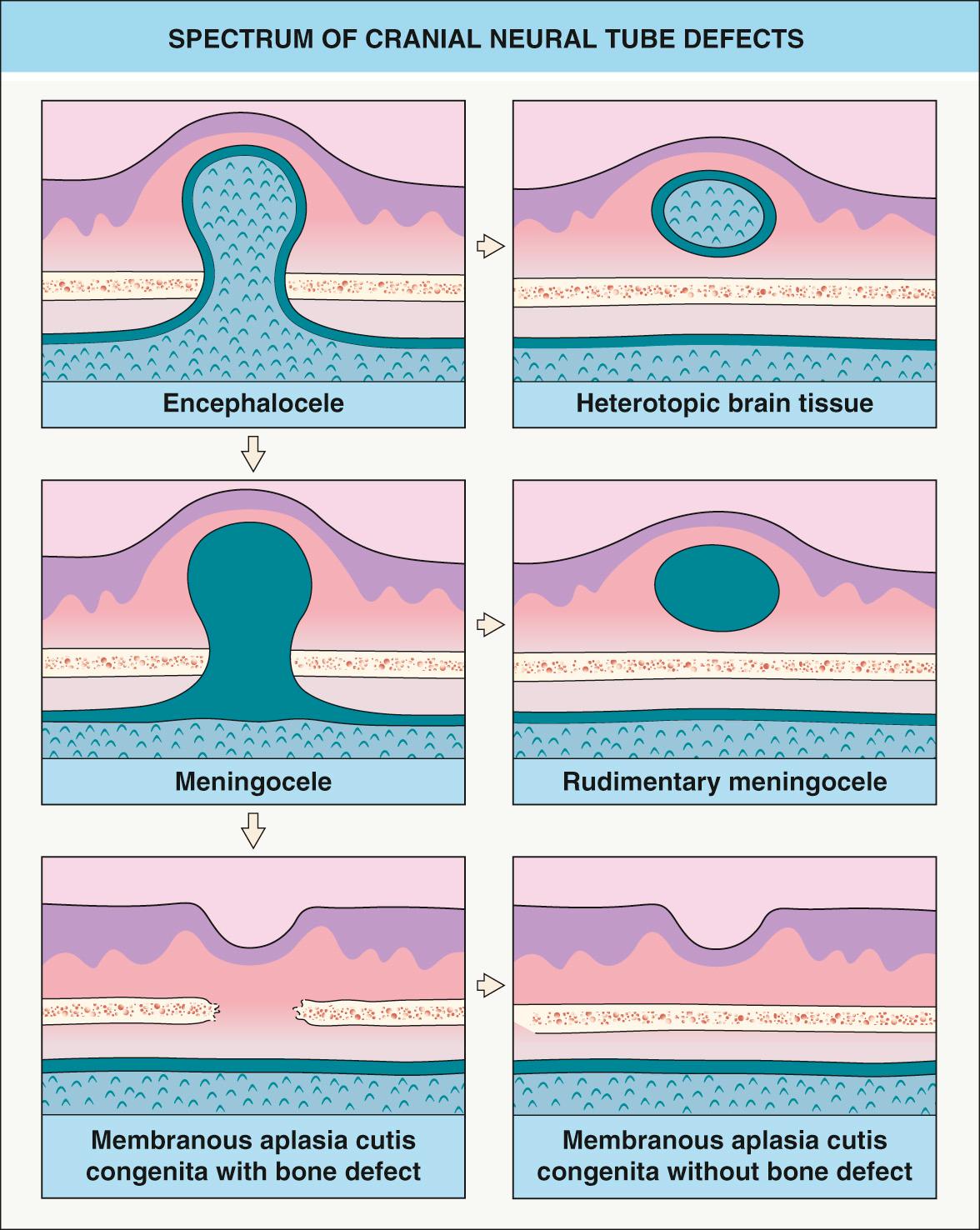
Cephaloceles typically appear as a soft, compressible, pulsatile mass with a bluish color. They may be covered with either normal skin or a thin, glistening epithelial membrane. The size of cephaloceles varies tremendously, from 1 cm nodules to lesions containing nearly half of the brain, and the size does not necessarily correlate with the extent of the underlying bony defect. Patients with intranasal cephaloceles often present with a broadened nasal bridge but no palpable mass, whereas lesions on the scalp may have an overlying capillary malformation and/or a surrounding hair collar (see above, Midline lesions of the scalp) . Transillumination frequently indicates the presence of CSF; in addition, increased flow of CSF into lesions with crying, the Valsalva maneuver, or compression of the jugular veins (Furstenberg test) may result in transient expansion. Leaks of CSF can occur (e.g. CSF rhinorrhea), and patients may have a history of meningitis. Nasal cephaloceles may develop in conjunction with facial clefts and other midline defects, while encephaloceles are often associated with neurologic abnormalities.
On histologic examination, encephaloceles show mature neuroglial tissue embedded in varying amounts of fibrous stroma. Heterotopic brain tissue (see Fig. 64.8 ) demonstrates similar features, and these lesions cannot be reliably distinguished histologically. When a patient is suspected of having a cephalocele, imaging studies and subsequent neurosurgical repair should be performed.
Become a Clinical Tree membership for Full access and enjoy Unlimited articles
If you are a member. Log in here